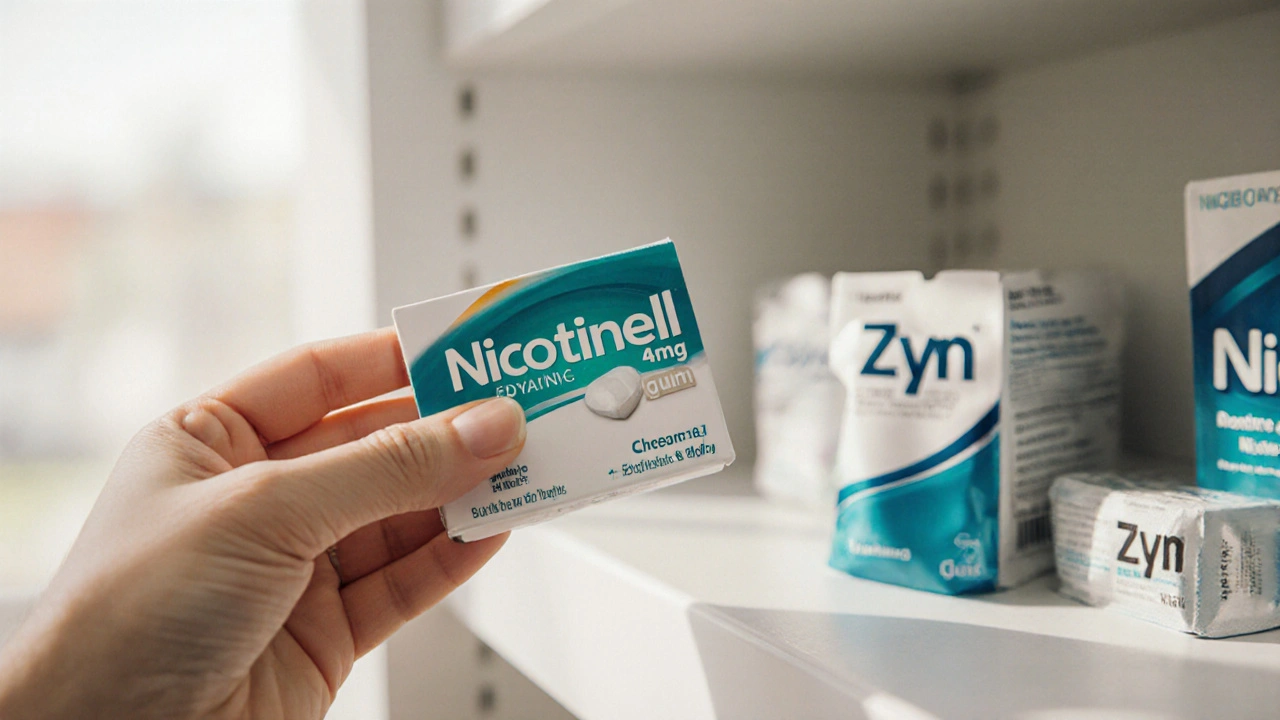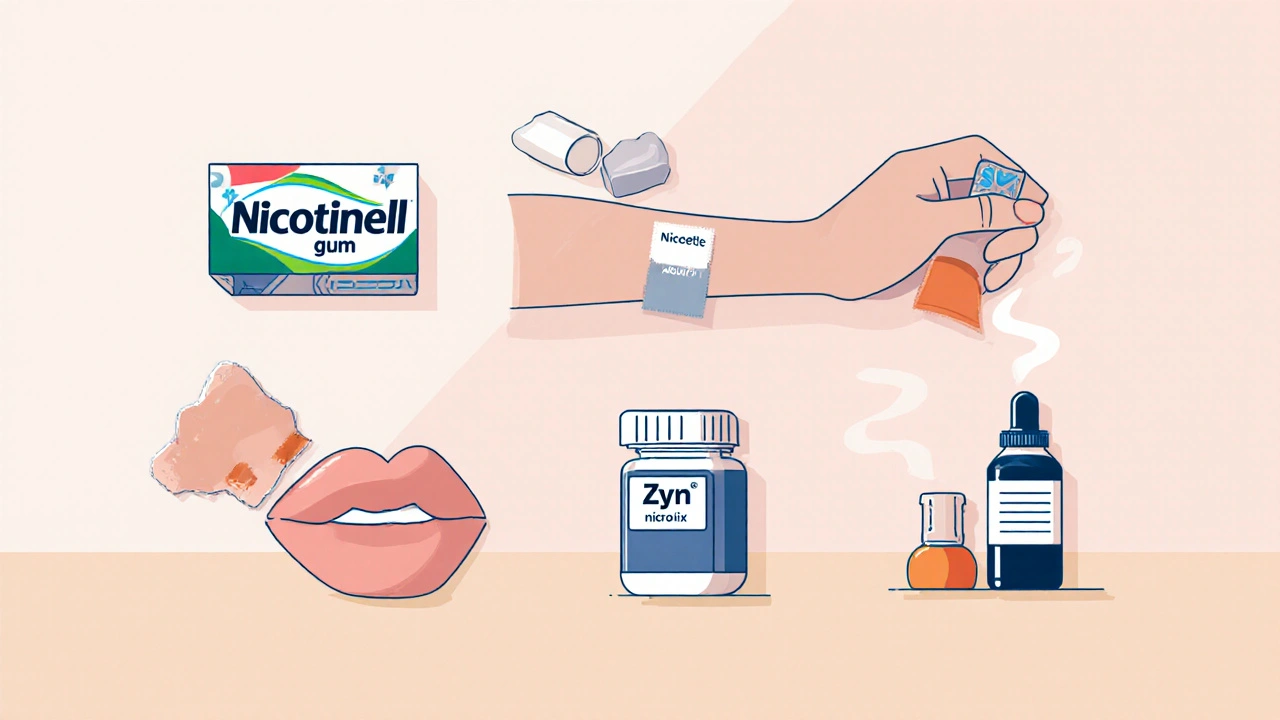Nicotinell Nicotine Gum vs Top Alternatives: Pros, Cons & Best Choice
 Oct, 12 2025
Oct, 12 2025
Ever wonder if that little piece of gum you chew can really beat the cravings, or if something else might work better? Nicotinell has been a staple on pharmacy shelves for years, but the market is flooded with patches, lozenges, pouches, and even prescription pills. Let’s break down how Nicotinell stacks up against the most popular alternatives, so you can pick the right tool for your quit‑smoking journey.
What is Nicotinell?
Nicotinell is a nicotine replacement therapy (NRT) gum that delivers a controlled dose of nicotine to help curb cravings. It comes in 2mg and 4mg strengths and is available over the counter in most pharmacies across NewZealand. The gum is chew‑and‑park: you chew until you taste a mild peppery flavor, then park it between your gum and cheek to absorb nicotine through the oral mucosa.
Key Alternatives on the Market
While Nicotinell is a solid option, several other NRT products and non‑NRT aids compete for the same space. Below are the six most common contenders you’ll encounter.
- Nicorette is another nicotine gum brand, offering 2mg and 4mg options with a slightly different flavor profile.
- Nicotine Patch is a transdermal adhesive that releases nicotine steadily over 16 or 24hours.
- Nicotine Lozenge dissolves in the mouth, providing a slower release than gum.
- Zyn Nicotine Pouch is a tobacco‑free pouch that sits under the lip and releases nicotine without any chewing.
- Champix (varenicline) is a prescription medication that targets nicotine receptors in the brain.
- E‑cigarette devices vaporize nicotine‑infused liquid, mimicking the hand‑to‑mouth motion of smoking.
How Do They Work? The Science in Plain English
All NRT products aim to replace the nicotine you’d normally get from a cigarette, but they differ in delivery speed and dosage control.
- Chewable gum (Nicotinell, Nicorette): Delivers nicotine quickly to the oral lining. The peak plasma nicotine level appears within 15‑30minutes, which is fast enough to tackle sudden cravings.
- Transdermal patch: Releases nicotine slowly over a full day, smoothing out baseline cravings but not ideal for sudden spikes.
- Lozenge: Similar to gum but slower because the nicotine is absorbed as the lozenge dissolves. Good for steady cravings.
- Pouch (Zyn): Provides a steady but adjustable release; you can pull the pouch out when a craving hits and replace it later.
- Prescription (Champix): Binds to nicotine receptors, reducing the pleasure you get from nicotine while also easing withdrawal symptoms.
- E‑cigarette: Delivers nicotine in vapor form, offering rapid absorption similar to smoking. However, device variability makes dose control tricky.
Cost Comparison (NZD, 2025)
| Product | Form | Typical Dosage Options | Average Monthly Price | Prescription Needed? | Side‑Effect Profile |
|---|---|---|---|---|---|
| Nicotinell | Chewing gum | 2mg, 4mg | $30‑$45 | No | Mild throat irritation, hiccups |
| Nicorette | Chewing gum | 2mg, 4mg | $28‑$42 | No | Similar to Nicotinell, occasional jaw soreness |
| Nicotine Patch | Transdermal | 7mg/24h, 14mg/24h, 21mg/24h | $40‑$55 | No | Skin irritation, sleep disturbances |
| Nicotine Lozenge | Oral lozenge | 2mg, 4mg | $35‑$50 | No | Throat irritation, nausea |
| Zyn Nicotine Pouch | Oral pouch | 3mg, 6mg | $45‑$60 | No | Dry mouth, gum irritation |
| Champix (varenicline) | Prescription tablet | 0.5mg, 1mg | $70‑$90 | Yes | Nausea, vivid dreams, mood changes |

Pros and Cons: Quick Reference
Below is a fast‑track cheat sheet that sums up the main strengths and weaknesses of each option.
- Nicotinell:
- Pros - Immediate craving relief, flexible dosing, no prescription, discreet.
- Cons - Requires chewing (not ideal for denture wearers), occasional hiccups.
- Nicorette:
- Pros - Same gum benefits, slightly milder flavor for sensitive palates.
- Cons - Similar side‑effects, price comparable.
- Nicotine Patch:
- Pros - Hands‑free, maintains steady nicotine level, great for nighttime cravings.
- Cons - Slower to curb sudden spikes, skin irritation for some users.
- Nicotine Lozenge:
- Pros - No chewing required, easy to use while driving or at work.
- Cons - Can cause throat soreness; slower onset than gum.
- Zyn Nicotine Pouch:
- Pros - No smoke, no spit, discreet, no oral irritation for many.
- Cons - Slightly higher price, not FDA‑approved for smoking cessation (off‑label).
- Champix:
- Pros - Addresses both physical and psychological cravings, often higher quit rates.
- Cons - Requires prescription, possible mood side‑effects, higher cost.
Who Should Choose Nicotinell?
If you prefer something you can pop in your pocket and chew only when a craving hits, Nicotinell is a solid pick. It works best for:
- Smokers who need fast relief after a stressful meeting.
- People who want to avoid skin adhesives.
- Those who want an over‑the‑counter option without a doctor's visit.
However, if you struggle with constant cravings throughout the day, a patch or prescription medication like Champix may smooth the overall nicotine curve better.
Real‑World Experiences: What Users Are Saying
We scoured NZ consumer forums, pharmacy feedback sheets, and a few recent surveys. Here’s a snapshot of the most common sentiments:
- Nicotinell: "The gum hits the spot within minutes. I love that I can keep a pack in my bag." - 34‑year‑old office worker.
- Nicorette: "Taste is milder, but I needed a bit more nicotine than the 2mg gave me." - 28‑year‑old graphic designer.
- Patch: "I woke up without any cravings for the first week, but the patch left a rash on my arm." - 45‑year‑old teacher.
- Zyn: "Great for social situations, no gum‑chewing in meetings. Costly, though." - 22‑year‑old student.
- Champix: "Helped me quit after 3 months, but the nausea was a real hurdle at the start." - 51‑year‑old accountant.
How to Use Nicotinell Effectively
Getting the most out of any NRT product hinges on proper technique. Follow these steps for Nicotinell:
- Start with a 2mg gum if you smoke fewer than 10 cigarettes a day; choose 4mg for heavier smokers.
- Chew slowly until you notice a peppery taste (about 15seconds).
- Park the gum between your gum and cheek; keep it there for about 30minutes.
- If cravings persist after 30minutes, chew another piece-but limit yourself to 6pieces per day.
- Avoid eating or drinking (especially acidic drinks) while using the gum, as this can reduce nicotine absorption.
Tip: Keep a water bottle handy for rinsing after each piece to prevent lingering flavor.

Potential Pitfalls and How to Avoid Them
- Over‑chewing: Chewing too fast releases nicotine all at once, leading to nausea. Stick to the “chew‑park” rhythm.
- Using the wrong strength: Heavy smokers using 2mg may feel unsatisfied, while light smokers on 4mg could experience dizziness. Match strength to your daily cigarette count.
- Mixing NRT forms without guidance: Combining gum with a patch can cause excess nicotine. If you want combo therapy, consult a pharmacist.
Bottom Line: Which Option Wins?
There’s no universal champion-your ideal product depends on lifestyle, budget, and how you experience cravings. Here’s a quick decision guide:
| If you need fast, on‑the‑spot relief: | Nicotinell or Nicorette gum. |
| If you hate chewing or have dental issues: | Nicotine lozenge or patch. |
| If you want a discreet, spit‑free option: | Zyn nicotine pouch. |
| If you need the strongest quit support and don’t mind a prescription: | Champix. |
Most people start with an over‑the‑counter product like Nicotinell, then adjust based on how their body reacts. The key is consistency-use the product as directed for at least 8‑12 weeks and pair it with behavioral support (quit‑lines, counseling, or a buddy system).
Next Steps: Craft Your Personal Quit Plan
Ready to take action? Here’s a simple three‑phase plan that works with Nicotinell or any of the alternatives:
- Set a quit date within the next two weeks. Mark it on your calendar and tell a friend.
- Choose your product based on the decision guide above. Stock up on enough supply to cover the first month.
- Build support by signing up for a free 12‑week phone counseling program offered by many NewZealand health agencies.
Track your cravings in a simple notebook: note the time, intensity (1‑10 scale), and which product you used. Patterns emerge, and you’ll see which tool truly works for you.
Frequently Asked Questions
Can I use Nicotinell while pregnant?
Health authorities generally advise against any nicotine use during pregnancy, including NRT like Nicotinell. If you’re pregnant and want to quit, talk to your GP about safer options, such as counseling or a tailored cessation plan.
How long should I stay on Nicotinell?
Most guidelines recommend using NRT for 8‑12 weeks, tapering down the dose as cravings lessen. Some people extend use up to 6 months if they still need occasional support.
Is Nicotinell safe for diabetics?
Nicotine can slightly raise blood glucose levels, so diabetics should monitor their sugar more closely when starting any NRT. Consult your endocrinologist for personalized advice.
Can I combine Nicotinell with a nicotine patch?
Combining two NRT forms can increase nicotine exposure, which may cause nausea or dizziness. It’s only recommended under professional supervision, typically for heavy smokers who need a “step‑down” approach.
What should I do if I experience hiccups from Nicotinell?
Hiccups are a common minor side‑effect. Try chewing more slowly, or switch to the 2mg strength if you’re on 4mg. If they persist beyond a few days, talk to a pharmacist about alternative NRT.

Brooks Gregoria
October 12, 2025 AT 20:17Honestly, the whole gum‑chew hype is just a placebo wrapped in a sugary stick. While manufacturers brag about “controlled nicotine release,” most smokers end up swapping one oral habit for another, and the habit itself is what fuels the addiction. The nicotine surge from Nicotinell peaks in half an hour, but the brain’s reward circuitry isn’t fooled that easily. You could argue that the extra money spent on gum could fund a real counseling program, which actually tackles the psychological grip. In the end, gum is a band‑aid for a broken bone, not a cure for the disease.
Sumit(Sirin) Vadaviya
October 23, 2025 AT 15:29Dear readers, the Nicotinell gum provides a rapid nicotine delivery system, which can be advantageous during acute cravings. It is important to follow the “chew‑park” protocol to maximize absorption and minimize oral irritation. 😊 Moreover, the over‑the‑counter availability ensures accessibility without a prescription. Should you experience persistent side‑effects, consulting a pharmacist is highly recommended. 📖
lindsey tran
November 3, 2025 AT 10:41OMG, I tried Nicotinell and it was like a superhero saving me from my cravings in seconds! The moment I felt that peppery zing, I knew I was back in control, no more panic attacks at the office. I was defnitely skeptical at first, but the gum literally vanished my urge like magic. 🙌 It's sooo convenient, I keep a pack in my bag and pull one out whenever the urge hits. If you're on the fence, just give it a shot – the relief is real and the hiccups are just a tiny price to pay.
Krishna Sirdar
November 14, 2025 AT 05:53That's an interesting point, Brooks. While the oral habit can indeed become a new ritual, many users find that the structured chew‑park method actually breaks the loop of automatic smoking. By replacing the cigarette with a timed gum session, the brain learns to associate cravings with a less harmful cue, which can gradually diminish the dependency.
becca skyy
November 25, 2025 AT 01:05From a cultural perspective, it's cool how Nicotinell fits into the everyday New Zealand routine – you can pop one at work, on a hike, or during a lunch break without drawing attention. Compared to the patch, which can look a bit clinical, the gum feels more like a casual habit rather than a medical device. This subtlety can make the quitting journey feel less like a big chore and more like a personal choice.